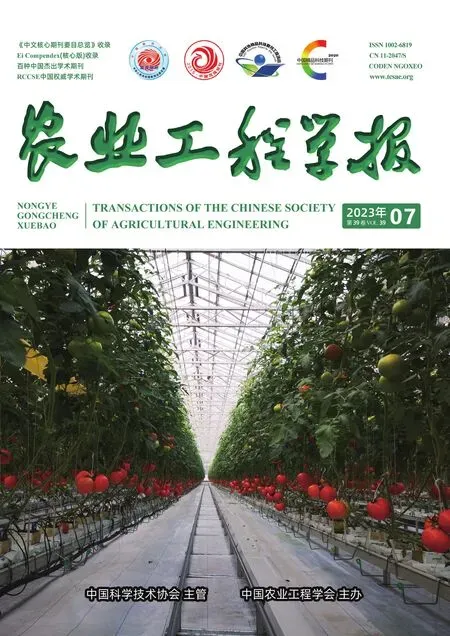基于CGA-BP神经网络的好氧堆肥曝气供氧量预测模型
丁国超,施雪玲,胡 军
基于CGA-BP神经网络的好氧堆肥曝气供氧量预测模型
丁国超1,施雪玲1,胡 军2※
(1. 黑龙江八一农垦大学信息与电气工程学院,大庆 163319; 2. 黑龙江八一农垦大学工程学院,大庆 163319)
为提高好氧堆肥曝气供氧量的曝气效率以及预测精度,该研究利用遗传算法(genetic algorithm, GA)对标准反向传播(back propagation, BP)神经网络的初始权值和阈值进行优化,再利用克隆选择算法(clonal genetic algorithm, CGA)优化遗传算法中的变异算子并复制算子,加快获取最优参数的速度,构建基于CGA-BP神经网络的曝气供氧量预测模型。为验证CGA-BP模型的有效性,与BP模型、GA-BP模型预测结果进行对比。试验结果表明:克隆遗传算法优化BP神经网络能加快获得最优解,效率相比BP模型和GA-BP模型分别提高了75.36%、51.30%;在曝气供氧量预测模型中,CGA-BP模型具有更准确的预测效果,预测精度为99.65%,而BP模型与GA-BP模型预测精度分别为96.99%、99.26%;CGA-BP模型评价指标的均方误差、平均绝对误差、平均绝对百分误差分别为0.003 4、0.038 9和0.350 6,均小于BP神经网络和GA-BP神经网络模型评价指标的误差;利用CGA-BP好氧堆肥曝气供氧量预测模型对好氧堆肥发酵过程进行精准曝气,提高了3.22%的曝气控制效率。由此可知CGA-BP神经网络模型有更好的预测效果,可满足好氧堆肥在发酵过程中曝气供氧量的需求,提高曝气效率,为精准控制曝气提供更直接有效的方法。
模型;试验;遗传算法;好氧堆肥;曝气供氧;BP神经网络;CGA-BP神经网络
0 引 言
中国年产各类有机废弃物大约有45~50亿t,其中农业废弃物9.8亿t、林业废弃物1.6亿t、有机生活垃圾1.5亿t、畜禽粪污19亿t左右[1-2]。随意弃置未被处理的有机废弃物不仅浪费大量资源,而且造成环境污染。好氧堆肥是对农业有机废弃物无害化处理和资源化利用的有效方式之一[3-5]。好氧堆肥发酵过程中,堆肥中存在的微生物起着重要的作用,能促进堆肥反应的正常进行并充分反应并腐熟的堆肥才可作为有机肥产品用于农业施肥,提高作物产量而曝气影响好氧堆肥中微生物的活性,能促进对有机物的氧化分解,曝气装置以及曝气量在一定程度上决定着好氧堆肥发酵中有机物分解的效率和腐熟程度。因此,曝气量在好氧堆肥发酵过程中起着至关重要的作用[6]。
国内外学者在精准控制曝气方面已进行了一些研究,既往大多利用曝气控制系统对曝气量进行控制。李升等[7]分析自动曝气系统运行情况,表明供氧量的控制精度稳定在1%左右,水中溶解氧的稳定程度超过0.9。沈军等[8]利用精确曝气系统研究污水池中的含氧量,通过参数控制,曝气池内的含氧量变化不超过±0.5 mg/L,水质达标率提升5%左右。唐维等[9]利用污水进出水的指标建立遗传算法优化BP神经网络模型,预测生化池的曝气量,测试样本数据预测误差在5%之内的比例达到98.67%。CHEN等[10]提出多变量最优控制模型,以曝气过程中的最小耗能作为目标函数,保证系统正常供氧量时实现最优控制,能耗降低20%左右。上述研究均是对污水进行曝气,与对好氧堆肥进行曝气的原料、方式有差异,好氧堆肥曝气量的研究大多是基于经验对堆肥定量定时进行曝气,按照一定通风速率间歇通气[11-12],曝气效率低。综上,曝气量作为影响堆肥发酵的重要因素,利用堆肥发酵过程中的多项指标与曝气量之间的关系建立曝气量预测模型,为能够有效指导堆肥顺利进行、提高曝气控制效率奠定基础。
本文从提高曝气效率出发,利用克隆选择算法(clonal genetic algorithm, CGA)的并行性、自适应性等优点,保持群体的多样性,搜索最优解的速度较快,并结合遗传算法优化BP(back propagation)神经网络初始权值和阈值[13-16],建立CGA-BP神经网络的曝气供氧量预测模型,以预测好氧堆肥发酵所需的曝气供氧量,缩短好氧堆肥发酵时间,为精准控制曝气提供有力的技术支撑。
1 材料与方法
1.1 试验装置
好氧堆肥试验以牛粪、牛粪沼渣、鸡粪和玉米秸秆为好氧堆肥原料,由北京市密云区海华沼气厂提供。其试验设备放置于北京市农林科学院科技成果展示示范温室,各原料初始理化参数如表1所示。
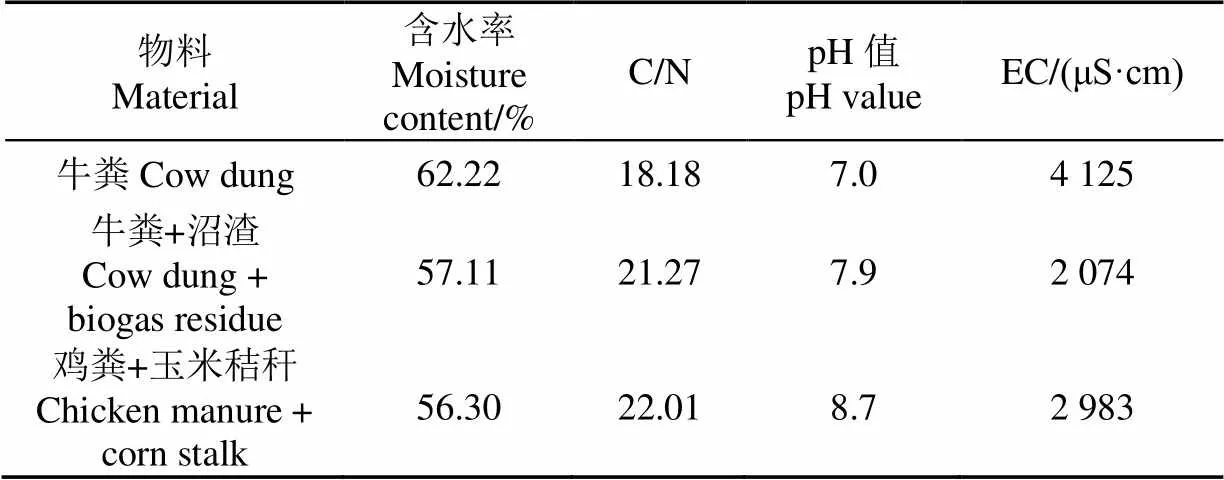
表1 堆肥原料初始理化参数
影响好氧堆肥发酵的因素主要包括堆体的温度、有机质含量、含水率、pH值、发氧浓度以及碳氮比等[17-19]。本文试验利用影响堆肥发酵的6个指标(温度、湿度、氧气浓度、室温、pH值和EC(electrical conductivity)值与曝气量的关系建立曝气量预测模型。各指标参数数据信息通过发酵罐内的不同类型传感器采集,好氧堆肥试验装置如图1所示,利用自主研发的控制器获取、传输并存储传感器数据。主要的传感器参数如表2所示,其中EP-200传感器是北京农林科学院根据DS18B20温度传感器与ECH2O土壤水分传感器自主研发的无线温湿度传感器。
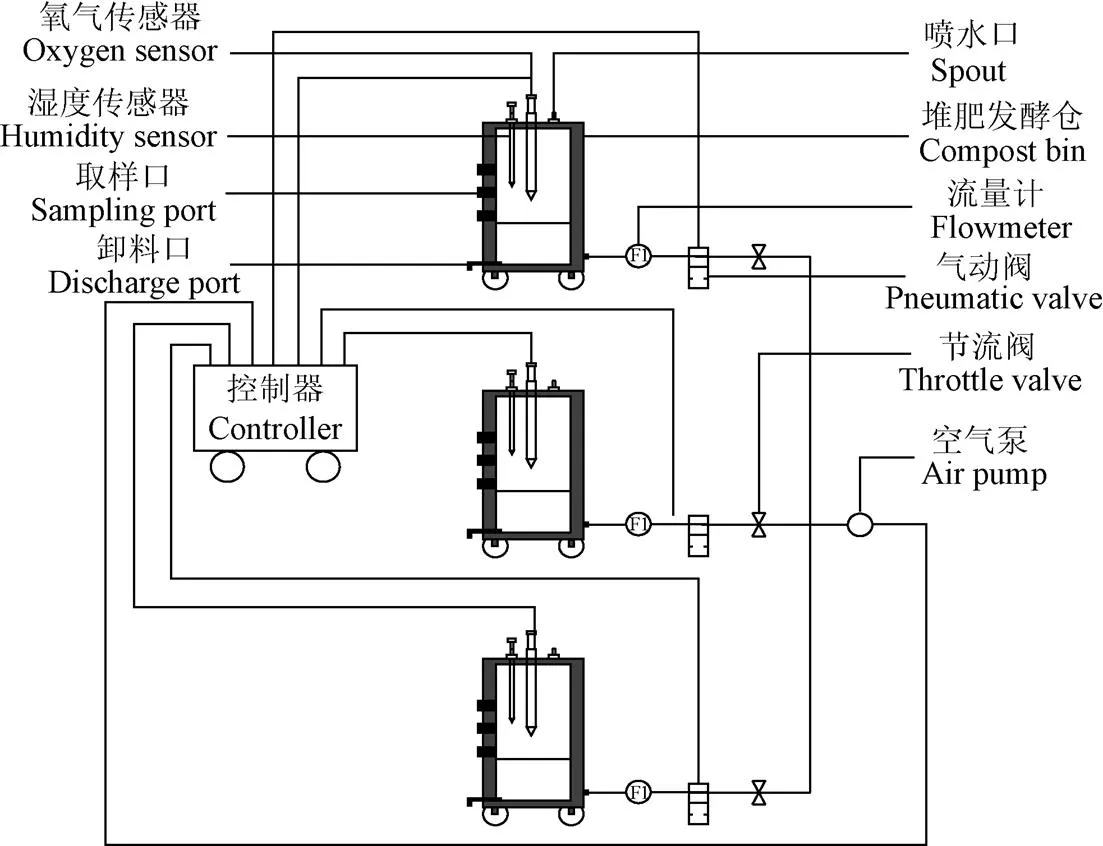
图1 好氧堆肥试验装置结构简图
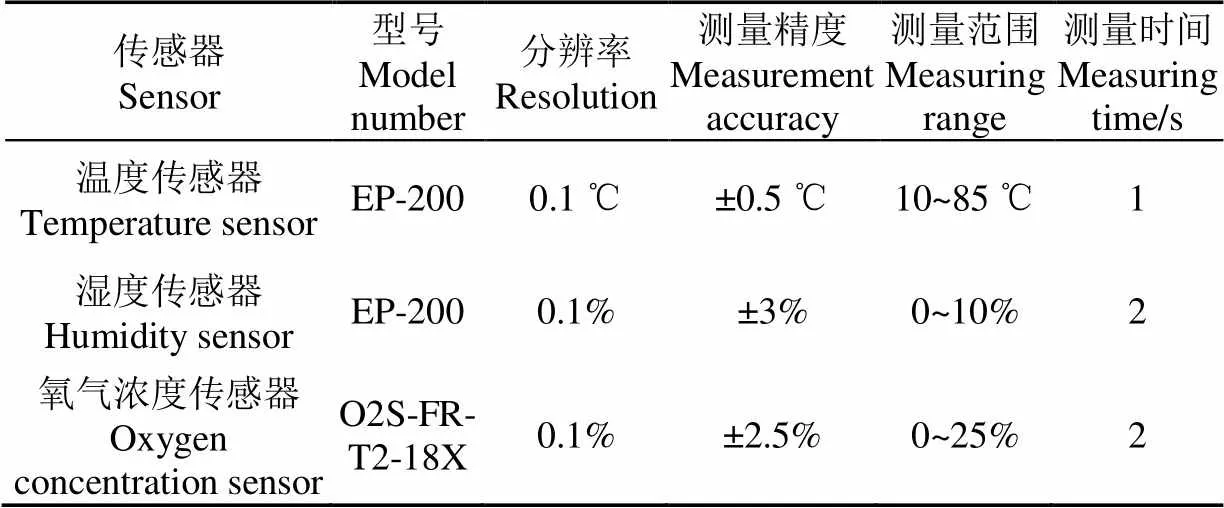
表2 温湿度、氧气浓度性能参数
1.2 数据来源及处理
1.2.1 数据来源及测定
试验选取的数据来源于2019年1月4日-22日的1号反应器数据。从堆肥发酵开始,每间隔2 h利用EP-200温湿度传感器以及O2S-FR-T2-18X氧气传感器分别采集一次数据,并在3个不同高度的取样口进行取样,均匀混合后取出等量样品180 g进行实验室化验分析,pH值与EC值分别采用按照国标土壤pH的测定(NY/T 1377-2007)和电导法测定。
1.2.2 数据预处理
好氧堆肥测定的指标数据单位均不同,为加快程序运行的收敛速度,对样本数据做归一化处理,本文采用mapminmax函数使数据均匀分布在[0,1]之间,其计算式为

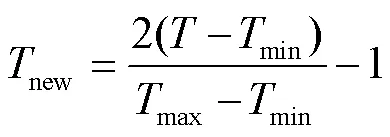
式中表示输入数据,表示输出数据;min和max分别表示的最小值和最大值;min和max分别为的最小值和最大值;new和new分别为归一化后的输入和输出数据。
试验修复样本数据、剔除异常值后,选取数据样本共268组,随机选择其中的218组数据作为测试集,余下的50组数据作为检验集。通过MATLAB分别建立BP、GA-BP、CGA-BP神经网络曝气供氧量预测模型,并计算模型误差,分析模型预测精度、平均绝对误差、平均绝对百分误差、均方根误差。
1.3 曝气供氧量预测模型的建立
1.3.1 BP神经网络
本次试验的BP神经网络的输入层、输出层的神经元个数分别设置为6和1。隐含层神经元个数会影响神经网络的性能,本文采用经验公式法来确定BP神经网络隐含层的节点数,选取网络误差最小时对应的隐含层节点数。常用的经验公式为

式中表示隐含层节点数目,为输入层节点数目,为输出层节点数目,为1~13之间的整数,根据式(3)确定隐含层神经元个数的范围为3~15。
运行程序,在样本集和训练次数相同的情况下,计算得出不同隐含层节点数的均方误差,如表3所示。从表3对比均方误差可知,均方误差最小,为0.000 447,对应的隐含层节点数为14。因此文中神经网络模型隐含层节点数设为14。
通过上述分析,本次试验建立的BP神经网络好氧堆肥曝气量的预测模型的输入层、隐含层和输出层的神经元个数分别为6、14、1,网络结构如图2所示。
1.3.2 GA-BP神经网络
本文将遗传算法与BP神经网络相结合,建立基于遗传算法优化BP神经网络的曝气供氧量预测模型,记作GA-BP神经网络模型[20]。遗传算法从任一初始种群出发,通过随机选择、交叉和变异操作获取的最优参数对BP神经网络的权值和阈值进行赋值和训练[21],计算种群适应度值,最终找出基于GA-BP神经网络的曝气供氧量预测模型的最优个体。

表3 不同隐含层节点数对应的均方误差
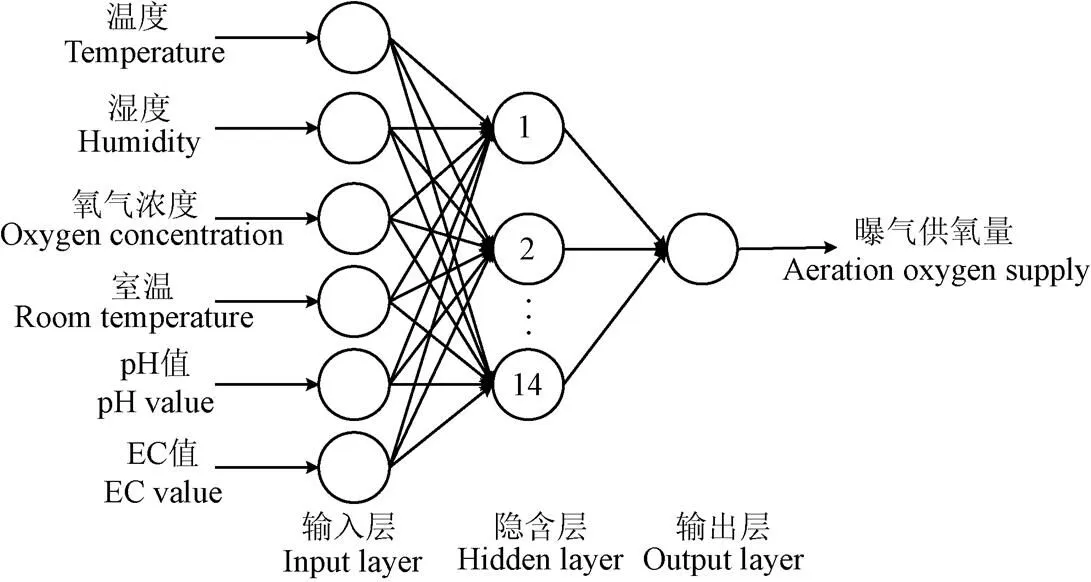
图2 BP神经网络模型结构图
GA优化BP神经网络算法参数主要有适应度函数、种群规模、迭代次数、交叉概率和变异概率,下面对主要参数设置进行确定:
1)适应度函数
用来度量种群中个体适应性的函数为适应度函数[22],试验中的适应度函数为:预测输出和期望之间的误差平方和的倒数。
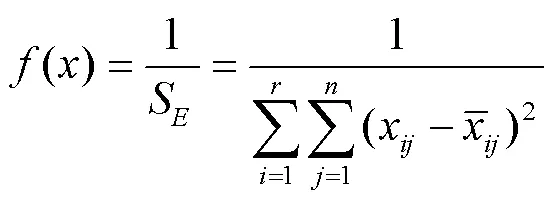

2)种群规模
初始解的个数即为种群规模,与个体基因的复杂程度有关。取值越大越利于找寻全局最优解,但运行时间过长。为了让初始解在解空间分布均匀,考虑时间及效率成本取种群规模为10~80[23],本文的种群规模由优化精度比较确定,结果如表4所示。

表4 不同种群规模、迭代次数算法误差比较
根据表4中的种群规模的优化精度算法对比,种群规模为40时,试验优化精度值最高。
3)迭代次数
遗传算法收敛时达到的精度和系统的性能会受到迭代次数的影响,需要平衡算法的精度和执行效率。利用适应度函数控制迭代次数,当迭代次数达到30时,算法已收敛(表4)。由表4中不同迭代次数的算法误差比较可知,设置迭代次数为30,此时算法误差最小为0.003 694。
4)交叉概率
通过交叉操作产生新的个体,可提高遗传算法的全局搜索能力[24]。交叉概率的大小要求尽可能不破坏个体结构和群体中优良的模式,但要有效产生较好的新个体模式。因此,交叉概率一般设置在0.40~0.99之间[23]。在此范围内,不同的交叉概率所对应算法误差比较如表5所示。
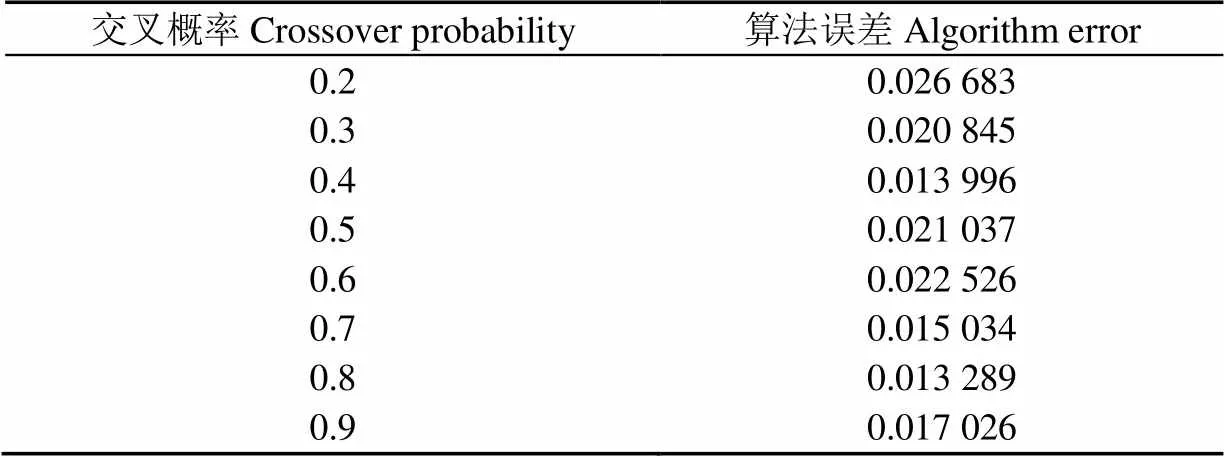
表5 不同交叉概率的算法误差比较
根据表5对比不同交叉概率所得算法误差可得,当交叉概率为0.8时,算法误差较小,为0.013 289。
5)变异概率
遗传算法的局部搜索能力会因设置变异概率的大小而变化。变异概率较大时,能够产生较多的新个体,但也可能改变较好的模式结构导致近似于随即搜索算法的性能[15];若变异概率取值太小,会抑制产生新的个体和抑制早熟现象的能力。一般限定在0.000 1~0.1之间以有效维持群体的多样性[23],试验中需要产生较多新个体搜索最优解,变异概率设置值最大时的算法模式结构并未被破坏,因此,试验的变异概率设置为0.1。
1.3.3 CGA-BP神经网络好氧堆肥的曝气供氧量预测模型的建立
为提高GA-BP算法运行效率,缩短GA-BP模型训练时间,本文利用克隆免疫算法优化GA-BP模型,该算法是2002年DE等通过仿生免疫反应中的亲和度的成熟过程提出的。克隆选择算法作为克隆免疫算法中的一种,具有自学习、记忆机制和并行性等优点,并成功应用于多模态函数优化、组合优化等方面[25]。BP神经网络经过克隆遗传算法优化后,记作CGA-BP神经网络模型。相比GA-BP神经网络模型、BP神经网络模型,CGA-BP神经网络模型加快了搜索最优解的速度,提升算法的运算效率。
克隆遗传算法以遗传算法为主,当进行遗传交叉和变异之后,利用克隆、高频变异保持群体的多样性,不断迭代得到最优个体[26]。本文建立的CGA-BP神经网络预测曝气供氧量模型的流程图,如图3所示。通过克隆选择算法对BP神经网络和GA的参数进行优化,采用比例复制算子和比例变异算子保持群体的多样性,同时利用记忆单元平衡全局与局部搜索的能力[27]。通过上述克隆遗传算法优化BP神经网络,CGA-BP神经网络预测曝气供氧量模型的参数设置如表6。
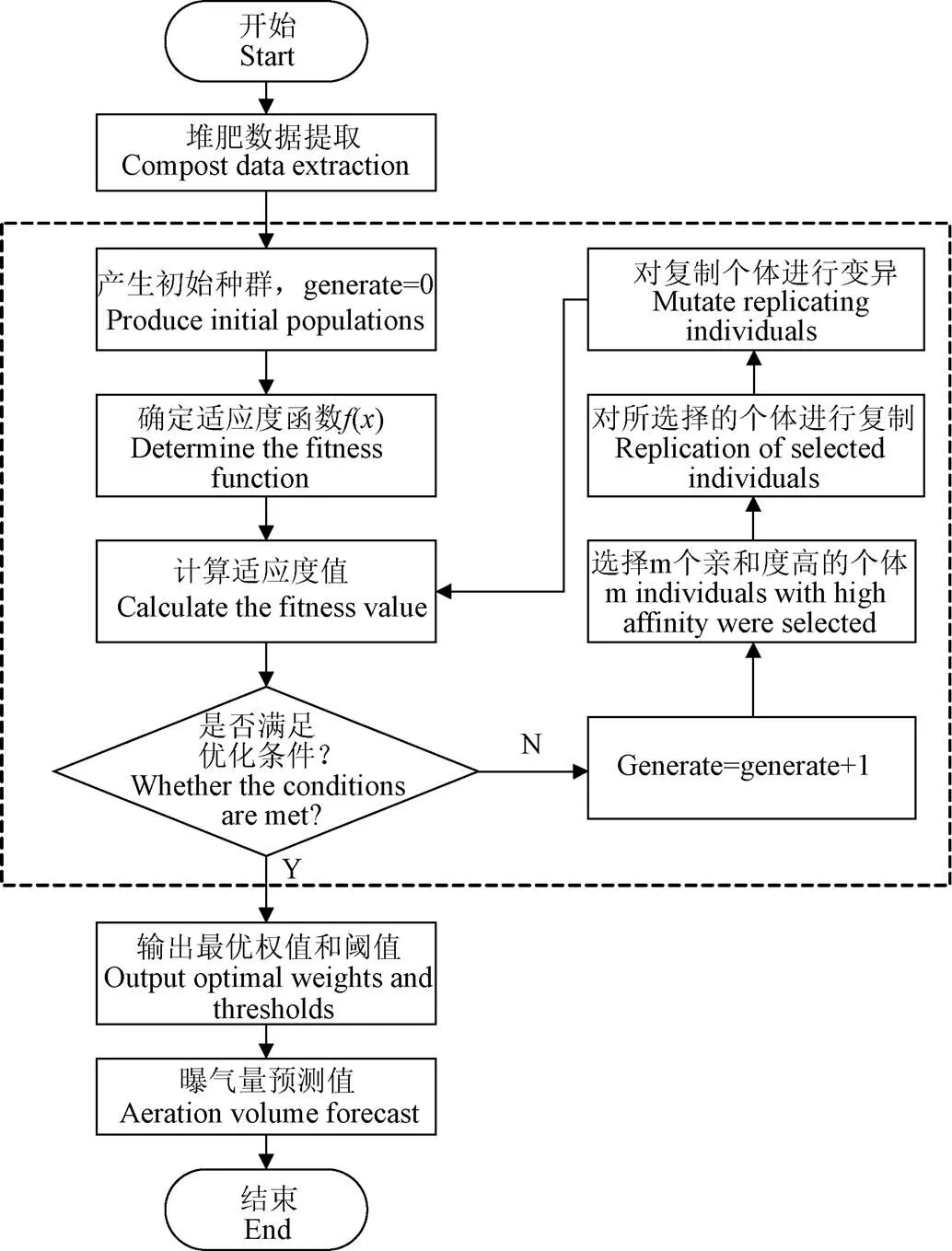
图3 基于CGA-BP神经网络的流程图

表6 CGA-BP神经网络模型参数设置
1.4 模型评价指标






2 结果与分析
2.1 模型预测结果
为检验克隆遗传算法优化BP神经网络的效果,本文利用测试集对训练好的BP模型、GA-BP模型和CGA-BP模型的好氧堆肥曝气供氧量预测效果进行对比分析,并分别将3种模型的预测值与真实值进行对比,结果如图4所示。
CGA-BP模型与真实值的拟合程度最好,预测精度达到99.65%,比BP模型、GA-BP模型的预测精度96.99%、99.26%分别提高2.66个百分点、0.39个百分点。CGA-BP神经网络算法、GA-BP神经网络算法和BP算法的曝气供氧量变化趋势与真实值变化趋势整体是一致的。但是本文提出的CGA-BP模型的预测精度相比其他2种模型都有一定提升。
本文通过影响堆肥发酵的多指标与曝气量的关系直接建立BP曝气供氧量模型、GA-BP曝气供氧量模型和CGA-BP曝气供氧量预测模型,3种模型中,CGA-BP模型预测精度最高。试验结果表明,CGA-BP模型预测曝气量能够更准确预测好氧堆肥发酵过程中堆肥实际需要的曝气量,提高堆肥曝气控制效率。
2.2 模型误差对比
BP神经网络算法、GA-BP神经网络和CGA-BP神经网络3种算法的曝气供氧量的绝对误差值比较,如图5所示。从图5中3个模型的绝对误差值可知,BP神经网络与GA-BP神经网络的误差波动范围较大,BP神经网络模型误差波动在±0.5,GA-BP神经网络模型误差波动在±0.4,而CGA-BP神经网络模型的误差稳定在±0.1之间,相比其他2个模型,绝对误差波动范围更小,预测结果更准确。
此外,将3种好氧堆肥的曝气供氧量预测模型的评价指标进行对比,结果见表7。CGA-BP模型的MAE值、MAPE值和MSE值分别为0.038 9、0.350 6、0.003 4,相比其他2个模型的性能指标也都有很大提升。GA-BP神经网络模型的MAE值、MAPE值和MSE值与BP模型相比,分别提高了29.49%、30.16%和53.25%,CGA-BP模型的MAE值、MAPE值和MSE值比GA-BP模型分别提高了53.16%、52.56%和74.43%。在搜索最优解的速度上,CGA-BP模型的效率也更高,比BP模型和GA-BP模型分别提高了75.36%、51.30%。
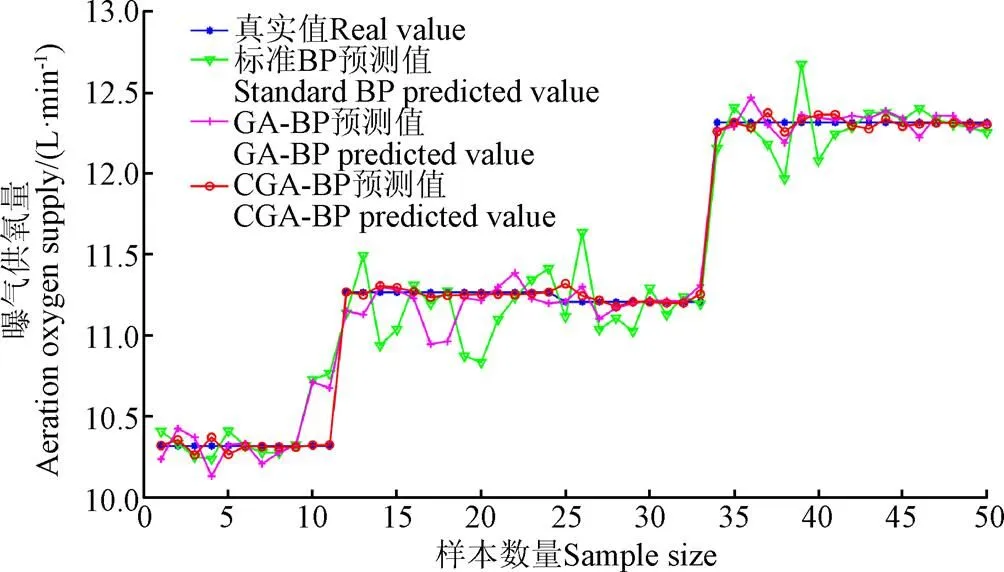
图4 BP、GA-BP和CGA-BP模型预测值和真实值比较

图5 BP、GA-BP和CGA-BP神经网络预测模型误差

表7 BP、GA-BP和CGA-BP模型评价指标对比
基于上述分析得出,克隆遗传算法起到了优化作用,CGA-BP好氧堆肥曝气供氧量预测模型优于GA-BP神经网络模型和BP神经网络模型,能够更好地预测曝气供氧量。
另一方面,CGA-BP模型是利用好氧堆肥实验装置控制传感器采集到的数据进行预测堆肥所需的曝气量,数据异常会影响曝气量预测结果的准确性,需要及时对各传感器进行定期维护和堆肥发酵过程中异常值的监测,保证预测结果的准确性,减少误差。
2.3 试验验证
选取北京市密云区海华沼气厂2019年2月2组堆肥数据进行分析。在整个好氧堆肥发酵过程中,一组数据根据CGA-BP模型预测的曝气量进行控制曝气,另一组数据直接利用实际值曝气作为对照组,并将CGA-BP模型预测曝气量和实际曝气量进行对比分析。两组好氧堆肥反应均完成后,对照组曝气量总共为3 366.67 m3/h,预测模型曝气量为3 257.82 m3/h,利用CGA-BP模型预测曝气量提高了约3.22%的曝气控制效率,并且根据CGA-BP模型预测曝气供氧量对堆肥进行精准曝气试验,比对照组提前6 h结束发酵过程,缩短了好氧堆肥发酵的时间,达到了节能减排的效果。
基于上述分析,通过建模方法的CGA-BP神经网络的好氧堆肥曝气供氧量预测模型能够实现精准曝气的效果并提高堆肥发酵效率。
3 结 论
本研究针对好氧堆肥曝气量的预测精度,利用样本数据训练神经网络,根据程序运行结果调整模型的参数,最终建立3种好氧堆肥曝气供氧量预测模型,对3种模型进行对比分析,结论如下:
1)克隆遗传算法对BP神经网络起到了优化作用,加快获得最优解,效率相比BP模型和GA-BP模型分别提高了75.36%、51.30%。
2)在好氧堆肥曝气供氧量预测模型中,CGA-BP模型的预测结果更佳,预测精度达到99.65%,比BP模型、GA-BP模型的预测精度分别提高2.66、0.39个百分点。CGA-BP模型的均方误差、平均绝对误差、平均绝对百分误差分别为0.003 4、0.038 9和0.350 6,均小于BP神经网络和GA-BP神经网络模型评价指标的误差。
3)CGA-BP好氧堆肥曝气供氧量预测模型的预测精度较高,能对好氧堆肥发酵过程实现精准曝气,提高了3.22%的曝气控制效率,并缩短了堆肥发酵时间。
[1] TOKARSKI D, ŠIMEČKOVÁ J, KUČERÍK J, et al. Detectability of degradable organic matter in agricultural soils by thermogravimetry[J]. Journal of Plant Nutrition and Soil Science, 2019, 182(5): 729-740.
[2] GUO H, GU J, WANG X, et al. Negative effects of oxytetracycline and copper on nitrogen metabolism in an aerobic fermentation system: Characteristics and mechanisms[J]. Journal of Hazardous Materials, 2021, 403: 123890.
[3] CUI X, GUO L, LI C, et al. The total biomass nitrogen reservoir and its potential of replacing chemical fertilizers in China[J]. Renewable and Sustainable Energy Reviews, 2021, 135: 110215.
[4] 沈玉君,张朋月,孟海波,等. 通风方式对猪粪堆肥主要臭气物质控制的影响研究[J]. 农业工程学报,2019,35(7):203-209.
SHEN Yujun, ZHANG Pengyue, MENG Haibo, et al. Study on the influence of ventilation mode on the control of main odorous substances in pig manure compost[J]. Transactions of the Chinese Society of Agricultural Engineering (Transactions of the CSAE), 2019, 35(7): 203-209. (in Chinese with English abstract)
[5] 张秧, 艾为党, 冯海艳,等. 小麦秸杆好氧堆肥过程中微生物多样性与优势菌群分析[J]. 农业工程学报, 2021, 37(11):206-212.
ZHANG Yang, AI Weidang, FENG Haiyan, et al. Analysis of microbial diversity and dominant microbiota during aerobic composting of wheat straw[J]. Transactions of the Chinese Society of Agricultural Engineering (Transactions of the CSAE), 2021, 37(11): 206-212. (in Chinese with English abstract)
[6] 王雅雅,陈高攀,孙浩,等. 基于EDEM的分仓立式好氧堆肥反应器设计与试验[J]. 农业工程学报,2023,39(3):171-179.
WANG Yaya, CHEN Gaopan, SUN Hao, et al. Design and test of separate silo vertical aerobic composting reactor based on EDEM[J]. Transactions of the Chinese Society of Agricultural Engineering, 2023, 39(3): 171-179. (in Chinese with English abstract)
[7] 李升,胡晓东,许飞飞,等. 马头岗污水厂精确曝气系统的实施及应用[J]. 中国给水排水,2016,32(15):26-31.
LI Sheng, HU Xiaodong, XU Feifei, et al. Implementation and application of precision aeration system of Matougang sewage plant[J]. Water Supply and Drainage in China, 2016, 32(15): 26-31. (in Chinese with English abstract)
[8] 沈军. 精确曝气系统(AVS)在 AAO 工艺中的运行分析[J]. 净水技术,2016,35(5):73-78.
SHEN Jun. Operational analysis of precision aeration system (AVS) in AAO processes[J]. Water Purification Technology, 2016, 35(5): 73-78.(in Chinese with English abstract)
[9] 唐维,陶钰欣,郝启文,等.基于遗传算法优化BP神经网络的曝气量预测[J].控制工程,2022,29(7):1600-1605.
TANG Wei, TAO Yuxin, HAO Qiwen, et al. Optimization of aeration prediction of BP neural network based on genetic algorithm[J]. Control Engineering, 2022, 29(7):1600-1605.(in Chinese with English abstract)
[10] CHEN Y S, ZHANG H J, YIN Y F, et al. Smart energy savings for aeration control in wastewater treatment[J]. Energy Reports, 2022, 8: 1711-1721.
[11] 王丽丽,许雷,姚纪宇,等.堆肥废气余热回用对寒区好氧堆肥的影响[J].农业工程学报,2022,38(7):237-244.
WANG Lili, XU Lei, YAO Jiyu, et al. Effect of waste heat reuse of compost waste gas on aerobic composting in cold areas[J]. Transactions of the Chinese Society of Agricultural Engineering(Transactions of the CSAE), 2022, 38(7): 237-244. (in Chinese with English abstract)
[12] 王友玲,邱慧珍,PHILIP Ghanney,等.通风方式对牛粪堆肥氨气排放与氮素转化的影响[J].农业机械学报,2020,51(11):313-320.
WANG Youling, QIU Huizhen, PHILIP Ghanney, et al. Effects of ventilation on ammonia emission and nitrogen conversion of cow manure compost[J]. Transactions of the Chinese Society for Agricultural Machinery, 2020, 51(11): 313-320. (in Chinese with English abstract)
[13] 李成杰,王涛,李海漪,等. 基于BP神经网络的堆肥物料抗剪强度预测模型[J]. 中国给水排水,2020,36(7):108-113.
LI Chengjie, WANG Tao, LI Haiyi, et al. Shear strength prediction model of compost materials based on BP neural network[J]. Water Supply and Drainage in China, 2020, 36(7): 108-113. (in Chinese with English abstract)
[14] 闻新. 智能故障诊断技术:MATLAB应用[M]. 北京:北京航空航天大学出版社,2015.
[15] ZHANG X, LIAO Z, MA L, et al. Hierarchical multistrategy genetic algorithm for integrated process planning and scheduling[J]. Journal of Intelligent Manufacturing, 2022, 33: 223-246.
[16] ZHENG Y C, XUE Y Y, YA L L, et al. Throughput optimization in cognitive wireless network based on clone selection algorithm[J]. Computers and Electrical Engineering, 2016, 52(5): 328-336.
[17] TRAN H T, LIN C, BUI X T, et al. Aerobic composting remediation of petroleum hydrocarbon-contaminated soil. Current and future perspectives[J]. Science of the Total Environment, 2021, 753: 142250.
[18] 刘娟,沈玉君,罗文海,等. 盐含量对餐厨垃圾好氧堆肥腐殖化过程及微生物演变的影响[J].农业工程学报,2022,38(19):190-201.
LIU Juan, SHEN Yujun, LUO Wenhai, et al. Effects of salt content on aerobic compost humification process and microbial evolution of food waste[J]. Transactions of the Chinese Society of Agricultural Engineering(Transactions of the CSAE), 2022, 38(19): 190-201. (in Chinese with English abstract)
[19] 杨佳,王国英,唐若兰,等. 生物炭和菌剂对羊粪微好氧堆肥腐熟度和温室气体排放的影响[J].农业工程学报,2022,38(10):224-231.
YANG Jia, WANG Guoying, TANG Ruolan, et al. Effects of biochar and fungicides on decay and greenhouse gas emissions of microaerobic compost of sheep manure[J]. Transactions of the Chinese Society of Agricultural Engineering(Transactions of the CSAE), 2022, 38(10): 224-231. (in Chinese with English abstract)
[20] ZHAO L, HU Y M, ZHOU W, et al. Estimation methods for soil mercury content using hyperspectral remote sensing[J]. Sustainability, 2018, 10(7): 2474.
[21] 郭利进,乔志忠. 基于遗传算法优化BP神经网络的粮食温度预测研究[J]. 粮食与油脂,2023,36(1):34-37,51.
GUO Lijin, QIAO Zhizhong. Research on grain temperature prediction based on BP neural network optimization based on genetic algorithm[J]. Grain and Fat, 2023, 36(1): 34-37, 51. (in Chinese with English abstract)
[22] ISMAIL F S, BAKAR N A. Adaptive mechanism for GA-NN to enhance prediction model[C] //Proceedings of the 9th International Conference on Ubiquitous Information Management and Communication, New York, US: ACM, 2015: 1-5.
[23] 周明,孙树栋. 遗传算法原理及应用[M]. 北京:国防工业出版社,1999.
[24] LIU R, LIU L. Predicting housing price in China based on long short-term memory incorporating modified genetic algorithm[J]. Soft Computing, 2019, 23(22): 11829-11838.
[25] DE C L N, VON Z F J. Learning and optimization using the clonal selection principle[J]. IEEE Transactions on Evolutionary Computation, 2002, 6(3): 239-251.
[26] 李阳,周步祥,林楠,等.修正克隆遗传算法在分布式电源规划中的应用[J].电力系统及其自动化学报,2013,25(4):128-132.
LI Yang, ZHOU Buxiang, LIN Nan, et al. Correction of the application of cloning genetic algorithm in distributed power planning[J]. Proceedings of the Department of Power Systems and its Automation, 2013, 25(4): 128-132.(in Chinese with English abstract)
[27] 谢宏,李云峰,禹文科,等. 改进免疫克隆选择算法的多目标轨迹优化[J]. 电子测量与仪器学报,2016,30(10):1534-1542.
XIE Hong, LI Yunfeng, YU Wenke, et al. Improved multi-objective trajectory optimization of immunocloning selection algorithm[J]. Journal of Electronic Measurement and Instrumentation, 2016, 30(10): 1534-1542. (in Chinese with English abstract)
[28] YAN J, XU Z, YU Y, et al. Application of a hybrid optimized BP network model to estimate water quality parameters of Beihai Lake in Beijing[J]. Applied Sciences, 2019, 9(9): 1863.
[29] 陈啸,王红英,孔丹丹,等.基于粒子群参数优化和BP神经网络的颗粒饲料质量预测模型[J]. 农业工程学报,2016,32(14):306-314.
CHEN Xiao, WANG Hongying, KONG Dandan, et al. Quality prediction model of pellet feed basing on BP network using PSO parameters optimization method[J]. Transactions of the Chinese Society of Agricultural Engineering (Transactions of the CSAE), 2016, 32(14): 306-314. (in Chinese with English abstract)
Prediction model of the aeration oxygen supply for aerobic composting using CGA-BP neural network
DING Guochao1, SHI Xueling1, HU Jun2※
(1.,,163319,;2.,,163319,)
Aerobic compost has been commonly used to efficiently dispose of resources recycling and environmental protection in modern agriculture. Among them, aeration can be one of the most important environmental factors to affect composting fermentation. It is necessary for a feasible network model to accurately control the oxygen supply of aeration. This study aims to improve the aeration efficiency and prediction accuracy of aerobic composting aeration. In-depth learning was selected to train a network model, in order to predict the oxygen supply of aeration during aerobic composting fermentation in this experiment. Raw materials were taken as cow dung, cow dung biogas residue, chicken manure, and corn straw in the Haihua Biogas Plant in Miyun District, Beijing, China. The corn straw was crushed by 1-2 cm in grain size. The cow dung, cow dung biogas residue, and chicken manure were uniformly mixed with the crushed corn straw for composting and fermentation. The sensor was used in the composting fermentation tank to collect the parameter data during aerobic fermentation. 268 groups of data were selected as the sample data, 218 groups of data were randomly selected as the input data, and 50 groups of data were selected as the test data. Clonal genetic algorithm (CGA) was used to predict the standard back propagation (BP) neural network model for the aeration oxygen supply, whereas, the 6-14-1 three-layer network structure was used as the basic structure of the prediction model. The input parameters were the temperature, humidity, oxygen concentration, room temperature, pH value, and electrical conductivity (EC). The mean square error (MSE) of the number of hidden layer nodes was determined to be 14 after training and calculation. The output data was aeration. This article establishes BP neural network model for predicting aeration oxygen supply. Then the genetic algorithm (GA) and clonal selection algorithm were used to improve the prediction accuracy of the model. The experiment shows that the CGA-BP neural network model has the best prediction effect on aeration oxygen supply. 1) The CGA-BP neural network model accelerated the obtaining of the optimal solution, with an efficiency improvement of 75.36% and 51.30% compared to the BP model and GA-BP model, respectively. 2) In the prediction model of aeration oxygen supply, the CGA-BP model had a more accurate prediction effect, with a prediction accuracy of 99.65%. The prediction accuracy of aeration oxygen supply was 96.99% and the prediction accuracy of the GA-BP neural network model reached 99.26%. A comparison was made to evaluate the errors of BP, GA-BP and CGA-BP neural models. The model evaluation showed that the best performance was found in the CGA-BP neural network model with the smallest error, as shown by the mean absolute error (MAE), mean absolute percentage error (MAPE) and mean square error (MSE). 3) The improved CGA-BP neural network model can be predicted the aeration oxygen supply of aerobic composting, increasing the aeration control efficiency by 3.22%. The improved model can be expected to accurately predict the aeration oxygen supply of aerobic compost. The finding can provide a strong reference for accurate data for the next aeration.
model; trial; genetic algorithms; aerobic composting; aerated oxygen supply; BP neural networks; CGA-BP neural networks
2022-11-09
2023-02-06
国家重点研发计划:农业废弃物好氧发酵技术与智能控制设备研发(2016YFD0800600)
丁国超,博士,副教授,研究方向为生物信息处理。Email:dgcer@163.com
胡军,博士,教授,研究方向为农业机械化工程。Email:gcxykj@126.com
10.11975/j.issn.1002-6819.202211088
TP183; TP389.1; S210.6
A
1002-6819(2023)-07-0211-07
丁国超,施雪玲,胡军. 基于CGA-BP神经网络的好氧堆肥曝气供氧量预测模型[J]. 农业工程学报,2023,39(7):211-217. doi:10.11975/j.issn.1002-6819.202211088 http://www.tcsae.org
DING Guochao, SHI Xueling, HU Jun. Prediction model of the aeration oxygen supply for aerobic composting using CGA-BP neural network[J]. Transactions of the Chinese Society of Agricultural Engineering (Transactions of the CSAE), 2023, 39(7): 211-217. (in Chinese with English abstract) doi:10.11975/j.issn.1002-6819.202211088 http://www.tcsae.org

